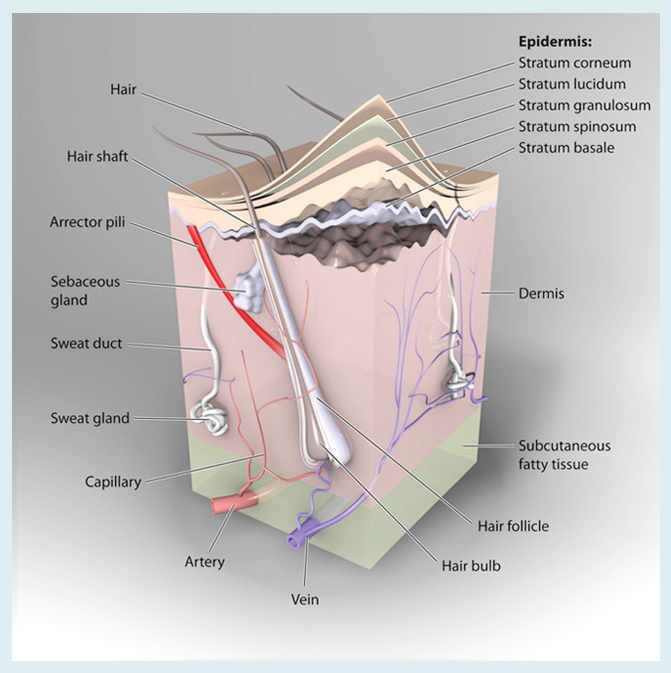The Skin

An average woman uses 12 personal care products daily. An average man uses about 6. One third of cosmetic products on the market contain chemicals linked to cancer.
The skin absorbs 60% of what we put on our face and body, which is known as transdermic penetration. (Example: nicotine patches for smoking and hormones for birth control are directly absorbed into the blood stream just by placing a patch on the skin).
Our blood brain barrier and lymphatic systems are located close to our face and once these toxic substances enter our bodies, our fatty tissues store the chemicals, leading to a host of problems.
The health of the interior body will reflex on the exterior of the body; the skin.
The cutis, or skin is our largest body organ. It consists of tissues structurally joined together to perform certain activities. The skin averages 8 to 10 pounds in weight and if stretched out would cover 16 to 20 square feet. An average adult’s skin weighs 12% to 15% of the total body weight.
The three layers of skin are: epidermal, dermal and subcutaneous.
The epidermal layer is the outermost and thinnest layer of the skin. It has small nerve endings and shows dry flakes, breakouts, freckles, sunburns, laugh lines, and wrinkles. The top layer of the skin consists of dead skin cells that have risen to the top and thus, the skin is constantly regenerating.
The dermal layer which is referred to as dermis lies below the epidermal layer and is an elastic layer of connective tissue. It contains an abundant blood supply and holds organs together. Its two main components are collagen and elastin. Fibers in the dermis impart the skin’s strength and resilience. This is where wrinkles are believed to begin. It is the home of the oil glands and without sufficient moisture, the elastin matrix and collagen lose their ability to keep skin supple and toned.
The subcutaneous layer referred to as the sub cutis layer is the deepest layer. It is the fatty layer that lies beneath the dermis and connects the underlying muscle tissue. The sub cutis layer keeps the body warm and protects the body from damage. This is also the layer in which body hair grows.
Elastin: Elastin is elastic! Elastin is a protein in connective tissue that is elastic and allows many tissues in the body to resume their shape after stretching or contracting.
Collagen: Elastin’s close sister. Elastin goes nowhere without collagen. Collagen is responsible for skin strength and elasticity. As it helps maintain the skin’s hydration, its degradation leads to wrinkles that accompany aging.
Blood Vessels: are nature’s highway, delivering the necessities of life to our organs.
Artery/Vein: Arteries are the muscular cousin of veins. They flex their stuff by carrying oxygenated blood away from the heart.
Stratum Corneum: are on the surface of your skin and they are dead. However, they protect inner layers of your skin; protects your skin from infection, dehydration, chemicals and mechanical stress. Alas, these dead cells help you stay healthy.
Sebaceous Glands and Sebum: Sebaceous glands are mother to sebum. Be nice to your sebaceous glands. They are temperamental. When activated too much they produce too much sebum which can create an existential art project called acne. But when coddled and properly motivated, it helps produce smooth, youthful skin and hair.
Stratum Lucidum: Yikes! Yet more dead cells. These are found mainly where your skin is thicker, mainly on the soles of your feet and hands. It makes your skin waterproof, a handy biological feature and protects your body from friction. Too bad, we can’t have stratum lucidum at our jobs.
Stratum Basale: The stratum basale is the bottom layer in the epidermis and is responsible for constantly renewing epidermal cells. Very deep. The deepest. They are considered the stem cells of the skin.
Stratum Spinosum: Yet another dead layer of skin! Does it ever end? They protect minor layers of skin and are shed every two weeks. Ever notice how often you change?
Nerve: A nerve conveys information in the form of electrochemical impulses (known as nerve impulses or action potentials) carried by the individual neurons that make up the nerve. There are sensory and motor nerves.
Lymphatic Vessel: The lymph system is a major mode of transportation. All aboard! Its main function is to collect and transport tissue fluids from the intercellular spaces in all the tissues of the body, back to the veins in the blood system; it plays an important role in returning plasma proteins to the bloodstream.
Sweat Glands: Ok, let’s face it; they can be nasty, especially in the gym or in closed hot, non-air-conditioned quarters. We’ve all been there. But they are very important and necessary. Sweat glands are used to regulate temperature and remove waste by secreting water, sodium salts, and nitrogenous waste (such as urea) onto the skin surface.
Try a .25oz sample for $8.00
